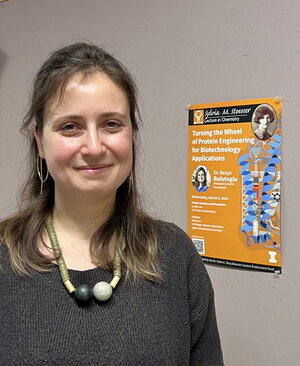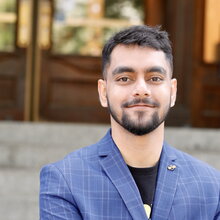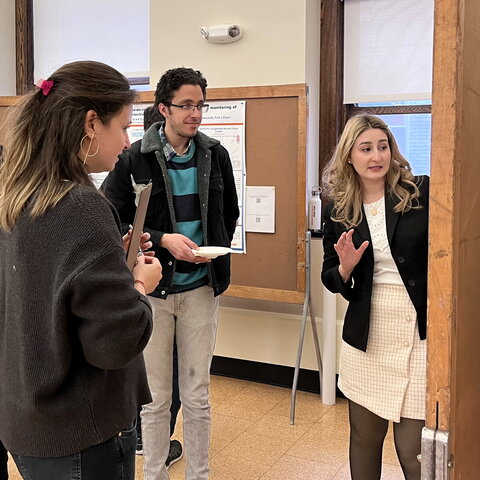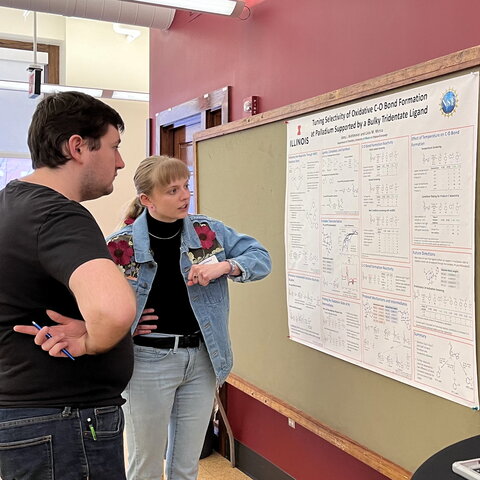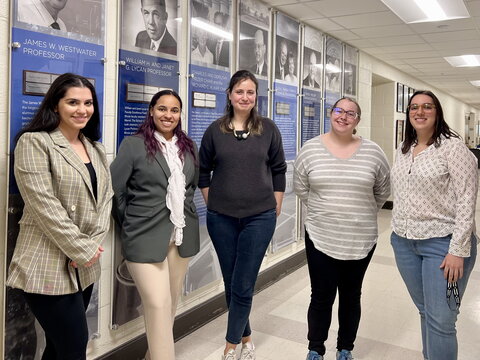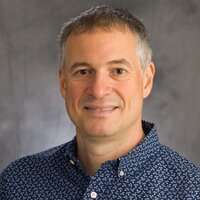Three graduate students in the Department of Chemistry received Stoesser Lecture Poster Session Awards. Suritra Bandyopadhyay, a PhD student in Prof. Jeff Chan’s lab, received the Top Presentation Award. And PhD students Amy Wahlmeier and Citlali Gutierrez from Prof. Liviu Mirica’s lab were runners up.
The Stoesser Lecture in Chemistry is held in honor of Dr. Sylvia Stoesser, an early pioneer for women in chemistry. The annual event includes a lecture given by an individual that is making outstanding contributions to science outside of academia, and a student poster session and awards ceremony. This year, the Stoesser Lecture Planning Committee selected Dr. Beyza Bulutoglu, Principal Scientist at Genentech, as the speaker. Dr. Bulutoglu served as one of the judges for the poster session.
Poster session award recipients
Suritra Bandyopadhyay presented his research on the development of a cancer therapeutic that helps eliminate side effects of traditional oncotherapies like chemotherapy and radiation therapy. There are numerous cancer drugs that are good at destroying rapidly growing cancer cells, but they can also attack other rapidly growing cells in the body, causing collateral damage in healthy tissue and contributing to severe side effects like fatigue, hair loss, bleeding, and multi-organ failures among others. Photodynamic therapy (PDT) is a treatment combining light energy with a photosensitizer drug that destroys cancer cells after it is activated by light, which limits damage to healthy cells because the light is focused on the cancerous cells. Bandyopadhyay’s research primarily focuses on further improving drugs for PDT, specifically one problem in which patients undergoing this treatment are sensitive to ambient light or sunlight and are advised to stay in the dark for weeks after receiving this treatment.
“To tackle this issue and to further improve the cancer selectivity of PDT, we designed a light-inert photosensitizer that requires a second layer of activation beyond light to unlock drug toxicity in cancer cells. The biomarker that we targeted to use as a key is a small, short-lived molecule called nitric oxide (NO), which is present at higher levels in the tumor microenvironment. We successfully demonstrated that when activated with both NO and light, the photosensitizer effectively suppressed tumor growth in two different mouse studies that we conducted,” Bandyopadhyay said. This research was recently published in the ACS journal Applied Materials and Interfaces.
Citlali Gutierrez is a chemistry PhD student in the Chemistry-Biology Interface-Training Program at Illinois and a National Science Foundation Graduate Research Fellow. She presented her research on the synthesis and development of novel diagnostic PET imaging agents for Alzheimer's disease and related dementias.
Although a proof-of-concept project, Gutierrez said her compounds seek to dual-target biomarkers of neurodegeneration with the purpose of pushing the earliest imaging window for AD patients to the presymptomatic clinical stage. This may shift the paradigm to proactive screening of elderly patients for late-onset AD which can then take advantage of the current therapeutic options available, Gutierrez explained. Note that these therapeutic options are limited to showing efficacy in the earliest stage of the disease, and, as of yet, these diseases have no cure, Gutierrez said. This research was funded by the Alzheimer's Association and the National Institutes of Health.
Amy Wahlmeier presented her research on the study of palladium catalyst reactions that will target specific carbon-hydrogen bonds to form new carbon–oxygen bond formation products under greener reaction conditions. Wahlmeier said the approach was to isolate and characterize the palladium intermediates that form during a reaction and use that information to design new catalysts or reaction conditions for improved carbon-oxygen bond formation products. Wahlmeier explained how she designed a novel palladium complex using a sterically bulky ligand, green oxidant screening, and characterization of palladium intermediates, which allowed for the study of a multi-purpose palladium complex with the ability to form:
—A highly selective and yielding C(sp2)–O bond formation product under mild conditions using a green oxidant.
—And a highly selective and yielding second (over-oxidized) C(sp2)–O bond formation product under different conditions using a green oxidant.
—And a selective C(sp2)–C bond formation.
This research provided new insights into palladium catalysts and their ability to be chemo selective.
